Recent Advances in Rechargeable Zn-Air Batteries
Abstract
:1. Introduction
2. Electrocatalyst: From Noble Metal to Non-Noble Metal
2.1. Noble Metal-Based Electrocatalysts
2.2. Non-Noble Metal Electrocatalysts
3. Electrode Chemistry: From the Oxygen Evolution Reaction to the Organic Oxidation Reaction
3.1. Urea Oxidation Reaction
3.2. Other Reactions

4. Electrode Engineering: From Powdery to Free-Standing
5. Liquid Electrolytes: From Alkaline to Non-Alkaline
5.1. Inorganic Salt Electrolytes
5.2. Organic Salt Electrolytes
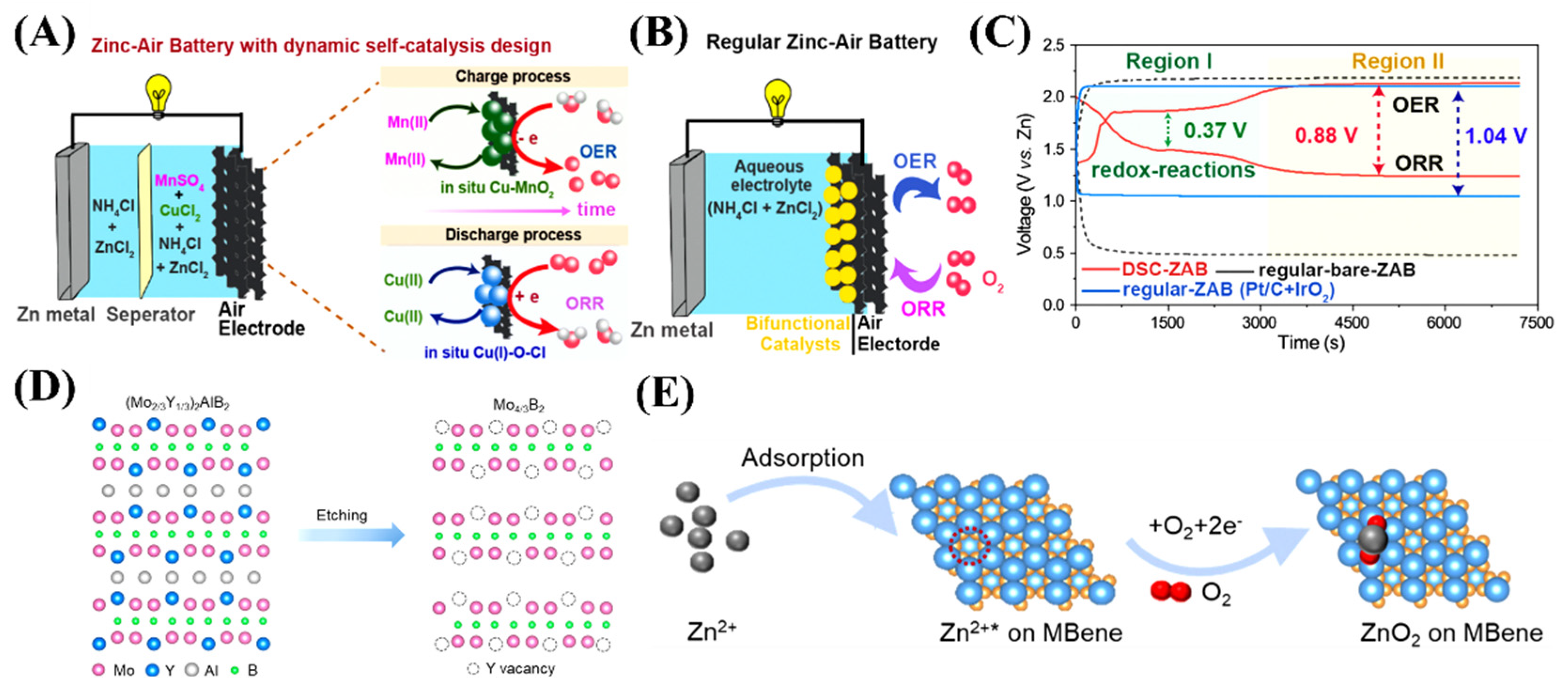
6. Battery Configuration: From Liquid to Flexible
6.1. Quasi-Solid-State/Solid-State Electrolytes
6.2. Battery Configuration for Flexible ZABs

7. Conclusions
Funding
Conflicts of Interest
References
- Cheng, F.Y.; Chen, J. Metal–air batteries: From oxygen reduction electrochemistry to cathode catalysts. Chem. Soc. Rev. 2012, 41, 2172–2192. [Google Scholar] [CrossRef] [PubMed]
- Amin, H.M.A.; Molls, C.; Bawol, P.P.; Baltruschat, H. The impact of solvent properties on the performance of oxygen reduction and evolution in mixed tetraglyme-dimethyl sulfoxide electrolytes for Li-O2 batteries: Mechanism and stability. Electrochim. Acta 2017, 245, 967–980. [Google Scholar] [CrossRef]
- Li, Y.G.; Lu, J. Metal−air batteries: Will they be the future electrochemical energy storage device of choice? ACS Energy Lett. 2017, 2, 1370–1377. [Google Scholar] [CrossRef]
- Yaqoob, L.; Noor, T.; Iqbal, N. An overview of metal-air batteries, current progress, and future perspectives. J. Energy Storage 2022, 56, 106075. [Google Scholar] [CrossRef]
- Chen, Y.H.; Xu, J.J.; He, P.; Qiao, Y.; Guo, S.H.; Yang, H.J.; Zhou, H.S. Metal-air batteries: Progress and perspective. Sci. Bull. 2022, 67, 2449–2486. [Google Scholar] [CrossRef]
- Leong, K.W.; Wang, Y.F.; Ni, M.; Pan, W.D.; Luo, S.J.; Leung, D.Y.C. Rechargeable Zn-air batteries: Recent trends and future perspectives. Renew. Sustain. Energy Rev. 2022, 154, 111771. [Google Scholar] [CrossRef]
- Cai, X.Y.; Lai, L.F.; Lin, J.Y.; Shen, Z.X. Recent advances in air electrodes for Zn-air batteries: Electrocatalysis and structural design. Mater. Horiz. 2017, 4, 945–976. [Google Scholar] [CrossRef]
- Zhou, C.H.; Chen, X.; Liu, S.; Han, Y.; Meng, H.B.; Jiang, Q.Y.; Zhao, S.M.; Wei, F.; Sun, J.; Tan, T.; et al. Superdurable Bifunctional Oxygen Electrocatalyst for High-Performance Zinc–Air Batteries. J. Am. Chem. Soc. 2022, 144, 2694–2704. [Google Scholar] [CrossRef]
- Kundu, A.; Mallick, S.; Ghora, S.; Raj, C.R. Advanced oxygen electrocatalyst for air-breathing electrode in Zn-air batteries. ACS Appl. Mater. Interfaces 2021, 13, 40172–40199. [Google Scholar] [CrossRef]
- Wang, H.F.; Tang, C.; Zhang, Q. A review of precious-metal-free bifunctional oxygen electrocatalysts: Rational design and applications in Zn-air batteries. Adv. Funct. Mater. 2018, 28, 1803329. [Google Scholar] [CrossRef]
- Tang, W.H.; Li, B.Y.; Teng, K.W.; Wang, X.D.; Liu, R.P.; Wu, M.W.; Zhang, L.; Ren, P.F.; Zhang, J.Q.; Feng, M. Advanced noble-metal-free bifunctional electrocatalysts for metal-air batteries. J. Mater. 2022, 8, 454–474. [Google Scholar] [CrossRef]
- Amin, H.M.A.; Baltruschat, H. How many surface atoms in Co3O4 take part in oxygen evolution? Isotope labeling together with differential electrochemical mass spectrometry. Phys. Chem. Chem. Phys. 2017, 19, 25527–25536. [Google Scholar] [CrossRef]
- Amin, H.M.A.; Apfei, U.P. Metal-rich chalcogenides as sustainable electrocatalysts for oxygen evolution and reduction: State of the art and future perspectives. Eur. J. Inorg. Chem. 2020, 2020, 2679–2690. [Google Scholar] [CrossRef]
- Zhang, Y.X.; Zheng, Y.; Deng, H.F.; Long, Y.T.; Jiang, W.N.; Li, C.; Li, S.P.; Li, Z.; Li, G.Y. Bioelectrochemical cascade reaction for energy-saving hydrogen production and innovative Zn-air batteries. Bioelectrochemistry 2024, 157, 108666. [Google Scholar] [CrossRef] [PubMed]
- Wang, Y.J.; Cao, Q.H.; Guan, C.; Cheng, C.W. Recent advances on self-supported arrayed bifunctional oxygen electrocatalysts for flexible solid-state Zn-air batteries. Small 2020, 16, 2002902. [Google Scholar] [CrossRef] [PubMed]
- Yadegari, H.; Sun, X.L. Recent advances on sodium−oxygen batteries: A chemical perspective. Acc. Chem. Res. 2018, 51, 1532–1540. [Google Scholar] [CrossRef]
- Tan, P.; Chen, B.; Xu, H.R.; Zhang, H.C.; Cai, W.Z.; Ni, M.; Liu, M.L.; Shao, Z.P. Flexible Zn- and Li-air batteries: Recent advances, challenges, and future perspectives. Energy Environ. Sci. 2017, 10, 2056–2080. [Google Scholar] [CrossRef]
- Kwak, W.J.; Rosy; Sharon, D.; Xia, C.; Kim, H.; Johnson, L.R.; Bruce, P.G.; Nazar, L.F.; Sun, Y.K.; Frimer, A.A.; et al. Lithium−oxygen batteries and related systems: Potential, status, and future. Chem. Rev. 2020, 120, 6626–6683. [Google Scholar] [CrossRef]
- Jiang, L.X.; Luo, X.X.; Wang, D.W. A review on system and materials for aqueous flexible metal–air batteries. Carbon Energy 2023, 5, e284. [Google Scholar] [CrossRef]
- Zhang, Y.L.; Goh, K.; Zhao, L.; Sui, X.L.; Gong, X.F.; Cai, J.J.; Zhou, Q.Y.; Zhang, H.D.; Li, L.; Kong, F.R.; et al. Advanced non-noble materials in bifunctional catalysts for ORR and OER toward aqueous metal–air batteries. Nanoscale 2020, 12, 21534–21559. [Google Scholar] [CrossRef]
- Wang, H.P.; Tan, R.; Yang, Z.X.; Feng, Y.Z.; Duan, X.C.; Ma, J.M. Stabilization perspective on metal anodes for aqueous batteries. Adv. Energy Mater. 2021, 11, 2000962. [Google Scholar] [CrossRef]
- Zhao, S.Y.; Liu, T.; Wang, J.; Bello, I.T.; Zuo, Y.Y.; Wei, M.H.; Wang, K.L.; Lau, K.K.S.; Ni, M. Anti-CO2 strategies for extending Zinc-air batteries’ lifetime: A review. Chem. Eng. J. 2022, 450, 138207. [Google Scholar] [CrossRef]
- Li, H.F.; Ma, L.T.; Han, C.P.; Wang, Z.F.; Liu, Z.X.; Tang, Z.J.; Zhi, C.Y. Advanced rechargeable zinc-based batteries: Recent progress and future perspectives. Nano Energy 2019, 62, 550–587. [Google Scholar] [CrossRef]
- Yu, J.; Li, B.Q.; Zhao, C.X.; Zhang, Q. Seawater electrolyte-based metal–air batteries: From strategies to applications. Energy Environ. Sci. 2020, 13, 3253–3268. [Google Scholar] [CrossRef]
- Li, H.; Chen, J.; Fang, J. Recent advances in wearable aqueous metal-air batteries: From configuration design to materials fabrication. Adv. Mater. Technol. 2023, 8, 2201762. [Google Scholar] [CrossRef]
- Sumboja, A.; Lübke, M.; Wang, Y.; An, T.; Zong, Y.; Liu, Z.L. All-solid-state, foldable, and rechargeable Zn-air batteries based on manganese oxide grown on graphene-coated carbon cloth air cathode. Adv. Energy Mater. 2017, 7, 1700927. [Google Scholar] [CrossRef]
- Li, Y.G.; Dai, H.J. Recent advances in zinc-air batteries. Chem. Soc. Rev. 2014, 43, 5257–5275. [Google Scholar] [CrossRef]
- Zhang, B.S.; Luo, Y.; Xiang, D.; Qin, J.D.; Miao, K.H.; Wang, X.F.; Kang, X.W.; Tian, Y. Yolk-shell structured zinc-cobalt-ruthenium alloy oxide assembled with ultra-small nanoparticles: A superior cascade catalyst toward oxygen evolution reaction. Adv. Funct. Mater. 2023, 33, 2214529. [Google Scholar] [CrossRef]
- Wang, M.L.; Yao, Y.; Yang, F.Y.; Tang, Z.W.; Ren, J.J.; Zhang, C.Z.; Wu, F.; Wang, X.K. Double spatial confinement on ruthenium nanoparticles inside carbon frameworks as durable catalysts for a quasi-solid-state Li–O2 battery. Carbon Energy 2023, 5, e334. [Google Scholar] [CrossRef]
- Lee, G.; Jang, E.; Su, P.C.; Kim, J. P-doped RuPd nanoparticles anchored on Y2Ru2-xPdxO7 pyrochlore oxide surface as oxygen evolution and reduction electrocatalysts for Zn-air battery. Appl. Surf. Sci. 2024, 657, 159788. [Google Scholar] [CrossRef]
- Qiao, S.C.; Shou, H.W.; Xu, W.J.; Cao, Y.Y.; Zhou, Y.Z.; Wang, Z.X.; Wu, X.J.; He, Q.; Song, L. Regulating and identifying the structures of PdAu alloys with splendid oxygen reduction activity for rechargeable zinc–air batteries. Energy Environ. Sci. 2023, 16, 5842–5851. [Google Scholar] [CrossRef]
- Zhang, S.M.; Chen, M.H.; Zhao, X.; Cai, J.L.; Yan, W.; Yen, J.C.; Chen, S.L.; Yu, Y.; Zhang, J.J. Advanced noncarbon materials as catalyst supports and non-noble electrocatalysts for fuel cells and metal–air batteries. Electrochem. Energy Rev. 2021, 4, 336–381. [Google Scholar] [CrossRef]
- Zhang, W.; Chang, J.F.; Wang, G.Z.; Li, Z.; Wang, M.Y.; Zhu, Y.M.; Li, B.Y.; Zhou, H.; Wang, G.F.; Gu, M.; et al. Surface oxygenation induced strong interaction between Pd catalyst and functional support for zinc–air batteries. Energy Environ. Sci. 2022, 15, 1573–1584. [Google Scholar] [CrossRef]
- Chen, X.X.; Guo, J.N.; Liu, J.L.; Luo, Z.Y.; Zhang, X.X.; Qian, D.; Sun-Waterhouse, D.X.; Waterhouse, G.I.N. Nanostructure engineering and electronic modulation of a PtNi alloy catalyst for enhanced oxygen reduction electrocatalysis in zinc-air batteries. J. Phys. Chem. Lett. 2023, 14, 1740–1747. [Google Scholar] [CrossRef] [PubMed]
- Roy, N.; Ahmed, M.S.; Lee, H.K.; Jeon, S. Intermetallic Pd–Y nanoparticles/N-doped carbon nanotubes as multi-active catalysts for oxygen reduction reaction, ethanol oxidation reaction, and zinc-air batteries. Nanoscale 2024, 16, 7532–7546. [Google Scholar] [CrossRef]
- Yan, F.F.; Zhang, H.C.; Wang, H.Y.; Jia, H.L.; Wang, J.J. Bilayer MXene-derived carbon-encapsulated palladium nanocatalysts: Engineering robust electronic and chemical interfaces for oxygen reduction and zinc-air batteries. Adv. Energy Mater. 2023, 13, 2202856. [Google Scholar] [CrossRef]
- Bai, T.S.; Li, D.P.; Xiao, S.Y.; Ji, F.J.; Zhang, S.; Wang, C.; Lu, J.Y.; Gao, Q.; Ci, L.J. Recent progress on single-atom catalysts for lithium–air battery applications. Energy Environ. Sci. 2023, 16, 1431–1465. [Google Scholar] [CrossRef]
- Yang, Z.; Jiang, N.; Bei, S.Y.; Bao, K.Y.; Xiang, M.; Yu, C.B.; Dong, S.; Qin, H.F. Single-atom palladium on nonstoichiometric tungsten oxide as bifunctional electrocatalyst for zinc-air battery. Electrochim. Acta 2024, 476, 143768. [Google Scholar] [CrossRef]
- Zhang, E.; Dong, A.Q.; Yin, K.; Ye, C.L.; Zhou, Y.; Tan, C.; Li, M.G.; Zheng, X.B.; Wang, Y.; Gao, X.W.; et al. Electron localization in rationally designed Pt1Pd single-atom alloy catalyst enables high-performance Li–O2 batteries. J. Am. Chem. Soc. 2024, 146, 2339–2344. [Google Scholar] [CrossRef]
- Pan, Y.D.; Li, Y.W.; Nairan, A.; Khan, U.; Hu, Y.; Wu, B.X.; Sun, L.; Zeng, L.; Gao, J.K. Constructing FeNiPt@C trifunctional catalyst by high spin-induced water oxidation activity for Zn-air battery and anion exchange membrane water electrolyzer. Adv. Sci. 2024, 11, 2308205. [Google Scholar] [CrossRef]
- Das, S.; Kundu, A.; Kuila, T.; Murmu, N.C. Recent advancements on designing transition metal-based carbon-supported single atom catalysts for oxygen electrocatalysis: Miles to go for sustainable Zn-air batteries. Energy Storage Mater. 2023, 61, 102890. [Google Scholar] [CrossRef]
- Yao, Z.C.; Tang, T.; Hu, J.S.; Wan, L.J. Recent advances on nonprecious-metal-based bifunctional oxygen electrocatalysts for zinc–air batteries. Energy Fuels 2021, 35, 6380–6401. [Google Scholar] [CrossRef]
- Ruan, Q.D.; Zhao, Y.C.; Feng, R.; Haq, M.U.I.; Zhang, L.; Feng, J.J.; Gao, Y.J.; Wang, A.J. Bimetal oxides anchored on carbon nanotubes/nanosheets as high-efficiency and durable bifunctional oxygen catalyst for advanced Zn-air battery: Experiments and DFT calculations. Small 2024, 2402104. [Google Scholar] [CrossRef] [PubMed]
- Park, M.G.; Hwang, J.; Deng, Y.P.; Lee, D.U.; Fu, J.; Hu, Y.F.; Jang, M.J.; Choi, S.M.; Feng, R.F.; Jiang, G.P.; et al. Longevous cycling of rechargeable Zn-air battery enabled by “raisin-Bread” cobalt oxynitride/porous carbon hybrid electrocatalysts. Adv. Mater. 2024, 36, 2311105. [Google Scholar] [CrossRef] [PubMed]
- Chang, H.; Zhao, L.L.; Zhao, S.; Liu, Z.L.; Wang, P.F.; Xie, Y.; Yi, T.F. Tuning interface mechanism of FeCo alloy embedded N,S-codoped carbon substrate for rechargeable Zn-air battery. J. Energy Chem. 2024, 93, 400–410. [Google Scholar] [CrossRef]
- Solani, M.; Amin, H.M.A.; Cebe, A.; Ayata, S.; Baltruschat, H. Metal-supported perovskite as an efficient bifunctional electrocatalyst for oxygen reduction and evolution: Substrate effect. J. Electrochem. Soc. 2021, 168, 034504. [Google Scholar] [CrossRef]
- Amin, H.M.A.; Baltruschat, H.; Wittmaier, D.; Friedrich, K.A. A highly efficient bifunctional catalyst for alkaline air-electrodes based on a Ag and Co3O4 hybrid: RRDE and online DEMS insights. Electrochim. Acta 2015, 151, 332–339. [Google Scholar] [CrossRef]
- Wittmaier, D.; Wagner, N.; Friedrich, K.A.; Amin, H.M.A.; Baltruschat, H. Modified carbon-free silver electrodes for the use as cathodes in lithium–air batteries with an aqueous alkaline electrolyte. J. Power Sources 2014, 265, 299–308. [Google Scholar] [CrossRef]
- Yan, Y.; Wen, B.H.; Liu, M.K.; Lei, H.; Yang, J.F.; He, S.Y.; Qu, Z.H.; Xia, W.; Li, H.L.; Zeng, J. Orienting electron fillings in d orbitals of cobalt single atoms for effective zinc–air battery at a subzero temperature. Adv. Funct. Mater. 2024, 34, 2316100. [Google Scholar] [CrossRef]
- Geng, J.; Ji, S.H.; Jin, M.; Zhang, C.; Xu, M.; Wang, G.Z.; Liang, C.H.; Zhang, H.M. Ambient electrosynthesis of urea with nitrate and carbon dioxide over iron-based dual-sites. Angew. Chem. Int. Ed. 2023, 62, e202210958. [Google Scholar] [CrossRef]
- Liu, H.; Jiang, L.Z.; Khan, J.; Wang, X.X.; Xiao, J.M.; Zhang, H.D.; Xie, H.J.; Li, L.N.; Wang, S.Y.; Han, L. Decorating single-atomic Mn sites with FeMn clusters to boost oxygen reduction reaction. Angew. Chem. Int. Ed. 2023, 62, e202214988. [Google Scholar] [CrossRef] [PubMed]
- Wang, Y.Z.; Yang, T.M.; Fan, X.; Bao, Z.J.; Tayal, A.; Tan, H.; Shi, M.K.; Liang, Z.Z.; Zhang, W.; Lin, H.P.; et al. Anchoring Fe Species on the Highly Curved Surface of S and N Co-Doped Carbonaceous Nanosprings for Oxygen Electrocatalysis and a Flexible Zinc-Air Battery. Angew. Chem. Int. Ed. 2024, 63, e202313034. [Google Scholar] [CrossRef] [PubMed]
- Rehman, F.; Kwon, S.; Musgrave, C.B.; Tamtaji, M.; Goddard, W.A., III; Luo, Z. High throughput screening to predict highly active dual-atom catalysts for electrocatalytic reduction of nitrate to ammonia. Nano Energy 2022, 103, 107866. [Google Scholar] [CrossRef]
- Tamtaji, M.; Kim, M.G.; Li, Z.M.; Cai, S.H.; Wang, J.; Galligan, P.R.; Hung, F.F.; Guo, H.; Chen, S.G.; Luo, Z.T.; et al. High-throughput screening of dual atom catalysts for oxygen reduction and evolution reactions and rechargeable zinc-air battery. Nano Energy 2024, 126, 109634. [Google Scholar] [CrossRef]
- Burshtein, T.Y.; Yakov Yasman, Y.; Muñoz-Moene, L.; Zagal, J.H.; Eisenberg, D. Hydrazine oxidation electrocatalysis. ACS Catal. 2024, 14, 2264–2283. [Google Scholar] [CrossRef]
- Gao, X.T.; Zhang, S.; Wang, P.T.; Jaroniec, M.; Zheng, Y.; Qiao, S.Z. Urea catalytic oxidation for energy and environmental applications. Chem. Soc. Rev. 2024, 53, 1552–1591. [Google Scholar] [CrossRef]
- Lao, X.Z.; Liao, X.J.; Chen, C.; Wang, J.S.; Yang, L.K.; Li, Z.; Ma, J.W.; Fu, A.P.; Gao, H.T.; Guo, P.Z. Pd-enriched-core/Pt-enriched-shell high-entropy alloy with face-centred cubic structure for C1 and C2 alcohol oxidation. Angew. Int. Chem. Ed. 2023, 62, e202304510. [Google Scholar] [CrossRef]
- Zhu, D.D.; Zhang, H.Y.; Miao, J.H.; Hu, F.X.; Wang, L.; Tang, Y.J.; Qiao, M.; Guo, C.X. Strategies for designing more efficient electrocatalysts towards the urea oxidation reaction. J. Mater. Chem. A 2022, 10, 3296–3313. [Google Scholar] [CrossRef]
- Tian, W.W.; Ren, J.T.; Wang, H.Y.; Wang, L.; Yuan, Z.Y. Bioinspired binary-site catalysts for novel urea-assisted Zn-air battery: A transfer station between renewable energy and hydrogen. Appl. Catal. B Environ. Energy 2024, 354, 124115. [Google Scholar] [CrossRef]
- Jiang, H.; Xia, J.; Jiao, L.; Meng, X.M.; Wang, P.F.; Lee, C.S.; Zhang, W.J. Ni single atoms anchored on N-doped carbon nanosheets as bifunctional electrocatalysts for Urea-assisted rechargeable Zn-air batteries. Appl. Catal. B Environ. 2022, 310, 121352. [Google Scholar] [CrossRef]
- Zhao, X.L.; Li, F.J.; Liang, S.T.; Liu, S.Y.; Sun, M.J.; Cui, Y.H.; Chi, B. Hollow spherical LaNiO3 perovskite with superior multifunctional performances and durability for urea-assisted Zn-air batteries. Appl. Surf. Sci. 2023, 637, 157898. [Google Scholar] [CrossRef]
- Li, H.H.; Liu, Y.Y.; Huang, L.L.; Xin, J.; Zhang, T.F.; Liu, P.; Chen, L.; Guo, W.; Gu, T.T.; Wang, G. 2D Metal–organic framework derived Co/CoSe2 heterojunctions with interfacial electron redistribution as bifunctional electrocatalysts for urea-assisted rechargeable Zn-air batteries. J. Mater. Chem. A 2023, 11, 5179–5187. [Google Scholar] [CrossRef]
- Zhang, Y.Q.; Zhou, B.; Wei, Z.X.; Zhou, W.; Wang, D.D.; Tian, J.; Wang, T.H.; Zhao, S.L.; Liu, J.L.; Tao, L.; et al. Coupling glucose-assisted Cu(I)/Cu(II) redox with electrochemical hydrogen production. Adv. Mater. 2021, 33, 2104791. [Google Scholar] [CrossRef] [PubMed]
- Li, G.Y.; Long, Y.T.; Li, Z.; Li, S.P.; Zheng, Y.; He, B.H.; Zhou, M.; Hu, Z.Q.; Zhou, M.J.; Hou, Z.H. Reducing the charging voltage of a Zn-air battery to 1.6 V enabled by redox radical-mediated biomass oxidation. ACS Sustain. Chem. Eng. 2023, 11, 8642–8650. [Google Scholar] [CrossRef]
- Zhao, S.Y.; Liu, T.; Dai, Y.W.; Wang, J.; Wang, Y.; Guo, Z.J.; Yu, J.; Bello, I.T.; Ni, M. Pt/C as a bifunctional ORR/iodide oxidation reaction (IOR) catalyst for Zn-air batteries with unprecedentedly high energy efficiency of 76.5%. Appl. Catal. B Environ. 2023, 320, 121992. [Google Scholar] [CrossRef]
- Chang, J.F.; Yang, Y. Recent advances in zinc-air batteries: Self-standing inorganic nanoporous metal films as air cathodes. Chem. Commun. 2023, 59, 5823–5838. [Google Scholar] [CrossRef]
- Shi, S.; Shen, Z.Z.; Li, S.S.; Wang, Q.; Wen, R.; Liu, B. High-yield synthesis of colloidal carbon rings and their applications in self-standing electrodes of Li–O2 batteries. J. Am. Chem. Soc. 2023, 145, 27664–27671. [Google Scholar] [CrossRef]
- Zheng, X.Y.; Zuria, A.M.; Mohamedi, M. Free-standing tunnel-structured MnO2 nanorods-doped with nickel and cobalt cations as bifunctional electrocatalysts for Zn-air batteries. Adv. Mater. Technol. 2023, 8, 2301142. [Google Scholar] [CrossRef]
- Yan, D.F.; Xia, C.F.; He, C.H.; Liu, Q.Q.; Chen, G.D.; Guo, W.; Xia, B.Y. A substrate-induced fabrication of active free-standing nanocarbon film as air cathode in rechargeable zinc–air batteries. Small 2022, 18, 2106606. [Google Scholar] [CrossRef]
- Lai, C.L.; Li, M.J.; Shen, Y.; Zhou, M.; Wang, W.; Jiang, K.; Li, H.M.; Wang, K.L. In Situ coupling of highly dispersed Ni/Fe metal-NC sites and N-doped 3D carbon fibers toward free-standing bifunctional cathode for flexible zinc-air battery. Energy Environ. Mater. 2024, 7, e12541. [Google Scholar] [CrossRef]
- Zhang, H.B.; Meng, Y.; Zhong, H.; Zhang, L.L.; Ding, S.C.; Fang, L.Z.; Li, T.; Mei, Y.; Hou, P.X.; Liu, C.; et al. Bulk preparation of free-standing single-iron-atom catalysts directly as the air electrodes for high-performance zinc-air batteries. Carbon Energy 2023, 5, e289. [Google Scholar] [CrossRef]
- Liu, H.M.; Wang, C.; Ai, X.B.; Wang, B.Q.; Bian, Y.Q.; Wang, G.Y.; Wang, Y.F.; Hu, Z.Z.; Zhang, Z.Q. Stabilizing iron single atoms with electrospun hollow carbon nanofibers as self-standing air-electrodes for long-time Zn-air batteries. J. Colloid Interface Sci. 2023, 651, 525–533. [Google Scholar] [CrossRef] [PubMed]
- Lv, X.W.; Wang, Z.L.; Lai, Z.Z.; Liu, Y.P.; Ma, T.Y.; Geng, J.X. Rechargeable zinc-air batteries: Advances, challenges, and prospects. Small 2024, 20, 2306396. [Google Scholar] [CrossRef] [PubMed]
- Wu, W.F.; Yan, X.B.; Zhan, Y. Recent progress of electrolytes and electrocatalysts in neutral aqueous zinc-air batteries. Chem. Eng. J. 2023, 451, 138608. [Google Scholar] [CrossRef]
- Wang, Q.C.; Kaushik, S.; Xiao, X.; Xu, Q. Sustainable zinc-air battery chemistry: Advances, challenges and prospects. Chem. Soc. Rev. 2023, 52, 6139–6190. [Google Scholar] [CrossRef]
- Clark, S.; Mainar, A.R.; Iruin, E.; Colmenares, L.C.; Blázquez, J.A.; Tolchard, J.R.; Latz, A.; Horstmann, B. Towards rechargeable zinc–air batteries with aqueous chloride electrolytes. J. Mater. Chem. A 2019, 7, 11387–11399. [Google Scholar] [CrossRef]
- Saha, S.; Gayen, P.; Ramani, V.K. Facet-dependent chlorine and oxygen evolution selectivity on RuO2: An Ab initio atomistic thermodynamic study. ChemCatChem 2020, 12, 4922–4929. [Google Scholar] [CrossRef]
- Zhang, T.R.; Lim, X.F.; Zhang, S.L.; Zheng, J.; Liu, X.F.; Lee, J.Y. Dynamic-self-catalysis as an accelerated air cathode for rechargeable near-neutral Zn-air batteries with ultrahigh energy efficiency. Mater. Horiz. 2023, 10, 2958–2967. [Google Scholar] [CrossRef]
- García-Caballero, V.; Lorca, S.; Villa-Moreno, M.; Caballero, Á.; Giner-Casares, J.J.; Fernández-Romero, A.J.; Cano, M. Human hemoglobin-based zinc-air battery in a neutral electrolyte. Energy Fuels 2023, 37, 18210–18215. [Google Scholar] [CrossRef]
- Xu, R.; Wang, X.K.; Sun, M.Z.; Zhang, C.H.; Zhang, C.; Li, Z.W.; Cao, M.; Gu, B.L.; Huang, M.H. Promoting oxygen reduction kinetics of single Fe sites for robust neutral Zn-air batteries via engineering synergistic Fe nanocluster as proton-feeding center. Chem. Eng. J. 2023, 475, 146065. [Google Scholar] [CrossRef]
- Wang, D.; Li, Q.; Zhao, Y.; Hong, H.; Li, H.; Huang, Z.; Liang, G.; Yang, Q.; Zhi, C. Insight on organic molecules in aqueous Zn-ion batteries with an emphasis on the Zn anode regulation. Adv. Energy Mater. 2022, 12, 2102707. [Google Scholar] [CrossRef]
- Han, D.; Cui, C.; Zhang, K.; Wang, Z.; Gao, J.; Guo, Y.; Zhang, Z.; Wu, S.; Yin, L.; Weng, Z.; et al. A non-flammable hydrous organic electrolyte for sustainable zinc batteries. Nat. Sustain. 2022, 5, 205–213. [Google Scholar] [CrossRef]
- Han, C.; Li, W.; Liu, H.K.; Dou, S.; Wang, J. Principals and strategies for constructing a highly reversible zinc metal anode in aqueous batteries. Nano Energy 2020, 74, 104880. [Google Scholar] [CrossRef]
- Sun, W.; Wang, F.; Zhang, B.; Zhang, M.; Küpers, V.; Ji, X.; Theile, C.; Bieker, P.; Xu, K.; Wang, C.; et al. A rechargeable zinc-air battery based on zinc peroxide chemistry. Science 2021, 371, 46–51. [Google Scholar] [CrossRef] [PubMed]
- Wang, F.M.; Qiu, K.; Zhang, W.; Zhu, K.R.; Chen, J.W.; Liao, M.C.; Dong, X.L.; Wang, F. Mesoporous carbon for high-performance near-neutral zinc–air batteries. Small 2024, 20, 2304558. [Google Scholar] [CrossRef]
- Hou, Y.; Chen, Z.; Li, X.L.; Wang, Y.Q.; Li, P.; Cui, H.L.; Zhang, R.; Yang, S.; Zhang, S.C.; Zhi, C.Y. MBene promoted Zn peroxide chemistry in rechargeable near-neutral Zn-air batteries. Energy Environ. Sci. 2023, 16, 3407–3415. [Google Scholar] [CrossRef]
- Wang, X.X.; Yang, X.X.; Liu, H.; Han, T.; Hu, J.H.; Li, H.B.; Wu, G. Air electrodes for flexible and rechargeable Zn-air batteries. Small Struct. 2021, 3, 2100103. [Google Scholar] [CrossRef]
- Sumboja, A.; Liu, J.W.; Zheng, W.G.; Zong, Y.; Zhang, H.; Liu, Z.L. Electrochemical energy storage devices for wearable technology: A rationale for materials selection and cell design. Chem. Soc. Rev. 2018, 47, 5919–5945. [Google Scholar] [CrossRef]
- Hosseini, S.; Soltani, S.M.; Li, Y.Y. Current status and technical challenges of electrolytes in zinc–air batteries: An in-depth review. Chem. Eng. J. 2021, 408, 127241. [Google Scholar] [CrossRef]
- Mainar, A.R.; Iruin, E.; Colmenares, L.C.; Kvasha, A.; Meatza, I.D.; Bengoechea, M.; Leonet, O.; Boyano, I.; Zhang, Z.C.; Blazquez, J.A. An overview of progress in electrolytes for secondary zinc-air batteries and other storage systems based on zinc. J. Energy Storage 2018, 15, 304–328. [Google Scholar] [CrossRef]
- Hui, X.B.; Zhang, P.; Li, J.F.; Zhao, D.Y.; Li, Z.Q.; Zhang, Z.W.; Wang, C.X.; Wang, R.T.; Yin, L.W. In situ integrating highly ionic conductive LDH-array@PVA gel electrolyte and MXene/Zn anode for dendrite-free high-performance flexible Zn-air batteries. Adv. Energy Mater. 2022, 12, 2201393. [Google Scholar] [CrossRef]
- Tran, T.N.T.; Clark, M.P.; Chung, H.J.; Ivey, D.G. Effects of crosslinker concentration in poly(acrylic acid)-KOH gel electrolyte on performance of zinc-air batteries. Batter. Supercaps 2020, 3, 409–416. [Google Scholar] [CrossRef]
- Xu, M.; Ivey, D.G.; Xie, Z.; Qu, W. Rechargeable Zn-air batteries: Progress in electrolyte development and cell configuration advancement. J. Power Sources 2015, 283, 358–371. [Google Scholar] [CrossRef]
- Miao, H.; Chen, B.; Li, S.H.; Wu, X.Y.; Wang, Q.; Zhang, C.F.; Sun, Z.X.; Li, H. All-solid-state flexible zinc-air battery with polyacrylamide alkaline gel electrolyte. J. Power Sources 2020, 450, 227653. [Google Scholar] [CrossRef]
- Alipoori, S.; Torkzadeh, M.M.; Moghadam, M.H.M.; Mazinani, S.; Aboutalebi, S.H.; Sharif, F. Graphene oxide: An effective ionic conductivity promoter for phosphoric acid-doped poly (vinyl alcohol) gel electrolytes. Polymer 2019, 184, 121908. [Google Scholar] [CrossRef]
- Xu, Y.; Zhang, Y.; Guo, Z.; Ren, J.; Wang, Y.; Peng, H. Flexible, stretchable, and rechargeable fiber-shaped zinc–air battery based on cross-stacked carbon nanotube sheets. Angew. Chem. Int. Ed. 2015, 54, 15390–15394. [Google Scholar] [CrossRef]
- Li, M.; Liu, B.; Fan, X.; Liu, X.; Liu, J.; Ding, J.; Han, X.; Deng, Y.; Hu, W.; Zhong, C. Long shelf-life polymer electrolyte based on tetraethylammonium hydroxide for flexible zinc-air batteries. ACS Appl. Mater. Interfaces 2019, 11, 28909–28917. [Google Scholar] [CrossRef]
- Yang, Y.; Wang, T.; Guo, Y.; Liu, P.G.; Han, X.F.; Wu, D.L. Agar-PVA/GO double network gel electrolyte for high performance flexible zinc-air batteries. Mater. Today Chem. 2023, 29, 101384. [Google Scholar] [CrossRef]
- Abedi, Z.; Cui, J.Y.; Chen, W.X.; Ivey, D.G. Zinc–air batteries with an efficient and stable MnCo2O4/carbon fiber bifunctional electrocatalyst and a poly(acrylic acid)-based gel electrolyte. ACS Appl. Energy Mater. 2022, 5, 14164–14174. [Google Scholar] [CrossRef]
- Cui, J.Y.; Labbe, M.; Chung, H.J.; Ivey, D.G. Low-temperature tolerant poly(acrylic acid) (PAA) gel polymer electrolytes for rechargeable zinc–air batteries. J. Mater. Chem. A 2023, 11, 13971–13983. [Google Scholar] [CrossRef]
- Song, Z.S.; Liu, X.R.; Ding, J.; Liu, J.; Han, X.P.; Deng, Y.D.; Zhong, C.; Hu, W.B. Poly(acrylic acid)-based composite gel polymer electrolytes with high mechanical strength and ionic conductivity toward flexible zinc–air batteries with long cycling lifetime. ACS Appl. Mater. Interfaces 2022, 14, 49801–49810. [Google Scholar] [CrossRef] [PubMed]
- Ao, K.L.; Zhang, X.Y.; Nazmutdinov, R.R.; Wang, D.; Shi, J.H.; Yue, X.; Sun, J.G.; Schmickler, W.; Daoud, W.A. Hierarchical CoFe@N-doped carbon decorated wood carbon as bifunctional cathode in wearable Zn-air battery. Energy Environ. Mater. 2024, 7, e12499. [Google Scholar] [CrossRef]
- Tran, T.N.T.; Aasen, D.; Zhalmuratova, D.; Labbe, M.; Chung, H.J.; Ivey, D.G. Compositional effects of gel polymer electrolyte and battery design for zinc-air batteries. Batter. Supercaps 2020, 3, 917–927. [Google Scholar] [CrossRef]
- Song, Z.S.; Ding, J.; Liu, B.; Liu, X.R.; Han, X.P.; Deng, Y.D.; Hu, W.B.; Zhong, C. A rechargeable Zn-air battery with high energy efficiency and long life enabled by a highly water-retentive gel electrolyte with reaction modifier. Adv. Mater. 2020, 32, 1908127. [Google Scholar] [CrossRef] [PubMed]
- Kim, K.W.; Kim, H.; Choi, J.; Choi, S.J.; Yoon, K.R. Internally connected porous PVA/PAA membrane with cross-aligned nanofiber network for facile and long-lasting ion transport in zinc-air batteries. Energy Storage Mater. 2024, 71, 103594. [Google Scholar] [CrossRef]
- Chen, Z.; Wang, K.L.; Fu, Y.X.; Zuo, Y.Y.; Wei, M.H.; Xiong, J.Y.; Wang, H.W.; Zhang, P.F.; Shang, N.; Zhong, D.Y.; et al. Locking water molecules loss of PAA hydrogel for flexible zinc-air battery with NaCl doping. Adv. Funct. Mater. 2023, 33, 2306223. [Google Scholar] [CrossRef]
- Shang, N.; Wang, K.L.; Wei, M.H.; Zuo, Y.Y.; Zhang, P.F.; Wang, H.W.; Chen, Z.; Zhong, D.Y.; Pei, P.C. Quasi-liquid gel electrolyte for enhanced flexible Zn-air batteries. Adv. Funct. Mater. 2023, 33, 2303719. [Google Scholar] [CrossRef]
- Zhang, P.; Wang, K.; Pei, P.; Zuo, Y.; Wei, M.; Liu, X.; Xiao, Y.; Xiong, J. Selection of hydrogel electrolytes for flexible zinc–air batteries. Mater. Today Chem. 2021, 21, 100538. [Google Scholar] [CrossRef]
- Zhang, Y.Q.; Wen, G.H.; Zhang, J.Y.; Qin, Y.T.; Cui, W.Y.; Luo, Z.Y.; Huang, B.Y.; Yu, J.F.; Wang, X.M. A lignocellulose-based hydrogel polymer electrolytes with high conductivity and stability for rechargeable flexible zinc-air batteries. J. Energy Storage 2024, 95, 112644. [Google Scholar] [CrossRef]
- Tang, K.; Yuan, C.Z.; Xiong, Y.; Hu, H.B.; Wu, M.Z. Inverse-opal-structured hybrids of N, S-codoped-carbon-confined Co9S8 nanoparticles as bifunctional oxygen electrocatalyst for on-chip all-solid-state rechargeable Zn-air batteries. Appl. Cat. B-Environ. 2020, 260, 118209. [Google Scholar] [CrossRef]
- Dou, H.Z.; Xu, M.; Zhang, Z.; Luo, D.; Yu, A.P.; Chen, Z.W. Biomass solid-state electrolyte with abundant ion and water channels for flexible zinc–air batteries. Adv. Mater. 2024, 36, 2401858. [Google Scholar] [CrossRef] [PubMed]
- Jiao, M.L.; Dai, L.X.; Ren, H.R.; Zhang, M.T.; Xiao, X.; Wang, B.R.; Yang, J.L.; Liu, B.L.; Zhou, G.M.; Cheng, H.M. A polarized gel electrolyte for wide-temperature flexible zinc-air batteries. Angew. Chem. Int. Ed. 2023, 62, e202301114. [Google Scholar] [CrossRef]
- Xu, M.; Cao, R.; Hao, B.Y.; Wang, D.D.; Luo, D.; Dou, H.Z.; Chen, Z.W. Single-anion conductive solid-state electrolytes with hierarchical ionic highways for flexible zinc-air battery. Angew. Chem. Int. Ed. 2024, 63, e202407380. [Google Scholar] [CrossRef] [PubMed]
- Yang, H.; Sun, X.H.; Li, X.Y.; Liu, Q.J.; Hu, W.B.; Zhang, L.Z. Janus Grotthuss-Vehicle mechanism enhances fast OH− transport for ultralong lifetime flexible zinc–air battery. Adv. Funct. Mater. 2024, 2409695. [Google Scholar] [CrossRef]
- Wang, Q.C.; Feng, Q.G.; Lei, Y.P.; Tang, S.H.; Xu, L.; Xiong, Y.; Fang, G.Z.; Wang, Y.C.; Yang, P.Y.; Liu, J.J.; et al. Quasi-solid-state Zn-air batteries with an atomically dispersed cobalt electrocatalyst and organohydrogel electrolyte. Nat. Commun. 2022, 13, 3689. [Google Scholar] [CrossRef]
- Li, B.Q.; Zhang, S.Y.; Wang, B.; Xia, Z.J.; Tang, C.; Zhang, Q. A porphyrin covalent organic framework cathode for flexible Zn-air batteries. Energy Environ. Sci. 2018, 11, 1723–1729. [Google Scholar] [CrossRef]
- Li, W.M.; Wang, Y.X.; Liu, R.J.; Chen, W.D.; Zhang, H.; Zhang, Z.Y. Gel Polymer-based composite solid-state electrolyte for long-cycle-life rechargeable zinc-air batteries. ACS Sustain. Chem. Eng. 2023, 11, 3732–3739. [Google Scholar] [CrossRef]
- Zuo, Y.Y.; Wang, K.L.; Wei, M.H.; Zhang, P.F.; Zhao, S.Y.; Pei, P.C.; Wang, H.W.; Chen, Z.; Shang, N. An Agar gel modulation with melamine foam skeleton for flexible Zn-air batteries. Chem. Eng. J. 2023, 452, 139301. [Google Scholar] [CrossRef]
- Fan, X.Y.; Zhang, R.; Sui, S.M.; Liu, X.R.; Liu, J.; Shi, C.S.; Zhao, N.Q.; Zhong, C.; Hu, W.B. Starch-based superabsorbent hydrogel with high electrolyte retention capability and synergistic interface engineering for long- lifespan flexible zinc-air batteries. Angew. Chem. Int. Ed. 2023, 62, e202302640. [Google Scholar] [CrossRef] [PubMed]
- Wang, X.X.; Xu, L.; Zhou, C.; Wong, N.H.; Sunarso, J.; Ran, R.; Zhou, W.; Shao, Z.P. Toward self-supported bifunctional air electrodes for flexible solid-state Zn-air batteries. Small Sci. 2023, 3, 2300066. [Google Scholar] [CrossRef]
- Fang, W.G.; Bai, Z.M.; Yu, X.X.; Zhang, W.; Wu, M.Z. Pollen-derived porous carbon decorated with cobalt/iron sulfide hybrids as cathode catalysts for flexible all-solid-state rechargeable Zn-air batteries. Nanoscale 2020, 12, 11746–11758. [Google Scholar] [CrossRef] [PubMed]
- Zhao, J.J.; Hu, H.B.; Wu, M.Z. N-Doped-carbon/cobalt-nanoparticle/N-doped-carbon multi-layer sandwich nanohybrids derived from cobalt MOFs having 3D molecular structures as bifunctional electrocatalysts for on-chip solid-state Zn-air batteries. Nanoscale 2020, 12, 3750–3762. [Google Scholar] [CrossRef] [PubMed]
- Zeng, S.; Tong, X.; Zhou, S.S.; Lv, B.; Qiao, J.; Song, Y.H.; Chen, M.H.; Di, J.T.; Li, Q.W. All-in-one bifunctional oxygen electrode films for flexible Zn-air batteries. Small 2018, 14, 1803409. [Google Scholar] [CrossRef] [PubMed]
- Liu, W.C.; Zhao, X.Y.; Ye, X.L.; Zheng, X.X.; Zhang, Y.; Wang, M.Y.; Lin, X.Y.; Liu, B.Q.; Han, L.; Ning, Y.F.; et al. Graphene oxide nanoribbon-based composite gel polymer electrolytes: Enhancing mechanical strength and ionic conductivity for long cycling lifetime of flexible zinc–air batteries. Energy Fuels 2024, 38, 6508–6517. [Google Scholar] [CrossRef]
- Fan, X.Y.; Wang, H.Z.; Liu, X.R.; Liu, J.; Zhao, N.Q.; Zhong, C.; Hu, W.B.; Lu, J. Functionalized nanocomposite gel polymer electrolyte with strong alkaline-tolerance and high zinc anode stability for ultralong-life flexible zinc-air batteries. Adv. Mater. 2023, 35, 2209290. [Google Scholar] [CrossRef]
- Shu, X.X.; Chen, Q.W.; Yang, M.M.; Liu, M.M.; Ma, J.Z.; Zhang, J.T. Tuning Co-catalytic sites in hierarchical porous N-doped carbon for high-performance rechargeable and flexible Zn-air battery. Adv. Energy Mater. 2023, 13, 2202871. [Google Scholar] [CrossRef]
- Ngo, Q.P.; Nguyen, T.T.; Singh, M.; Kim, N.H.; Lee, J.H. The Mott–Schottky Co2P/Co heterocatalyst encapsulated by N,P-doped graphene/carbon nanotubes as high-efficiency trifunctional electrocatalysts for cable-type flexible Zn-air batteries and water splitting. J. Mater. Chem. A 2024, 12, 1185–1199. [Google Scholar] [CrossRef]
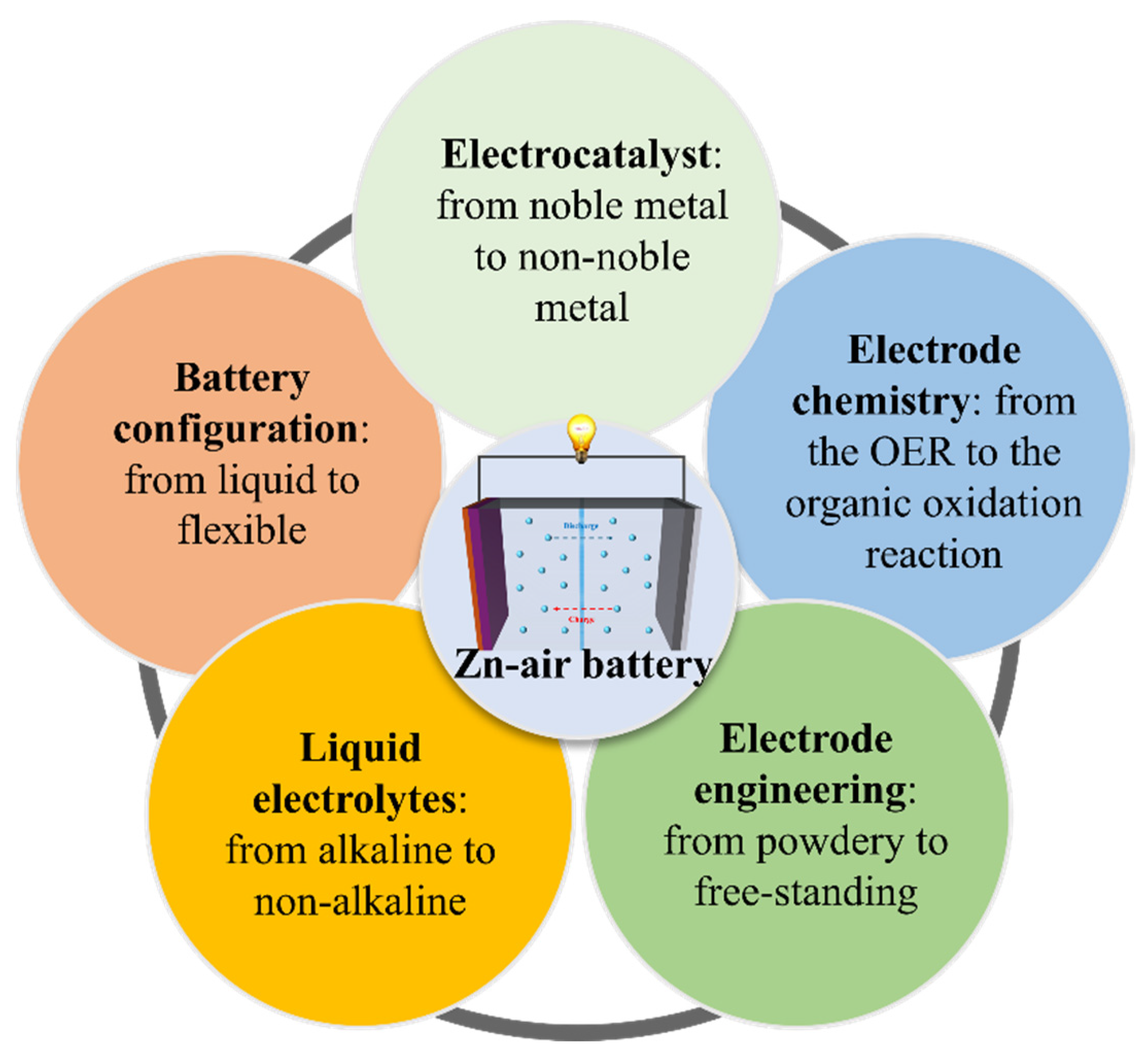
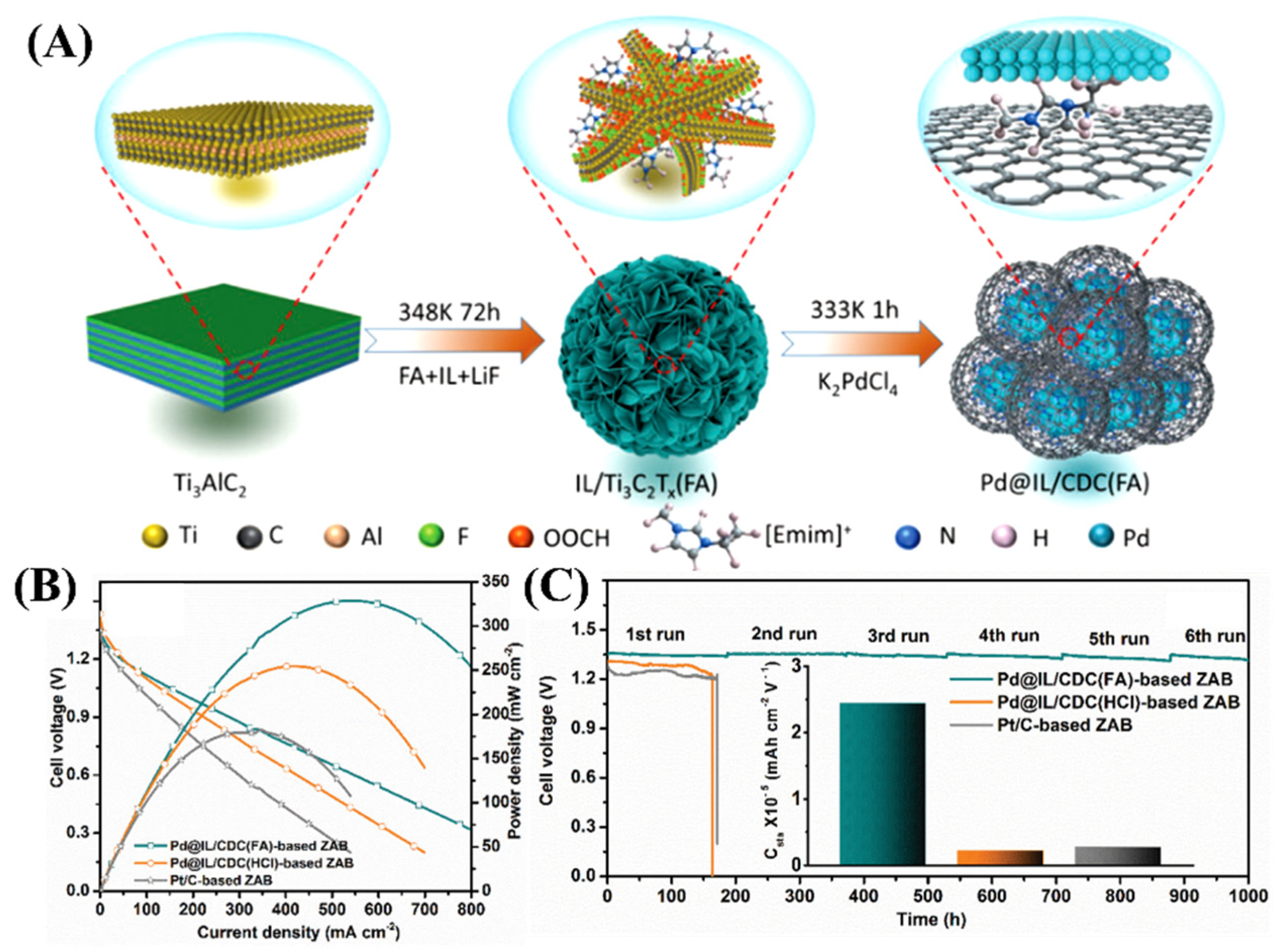

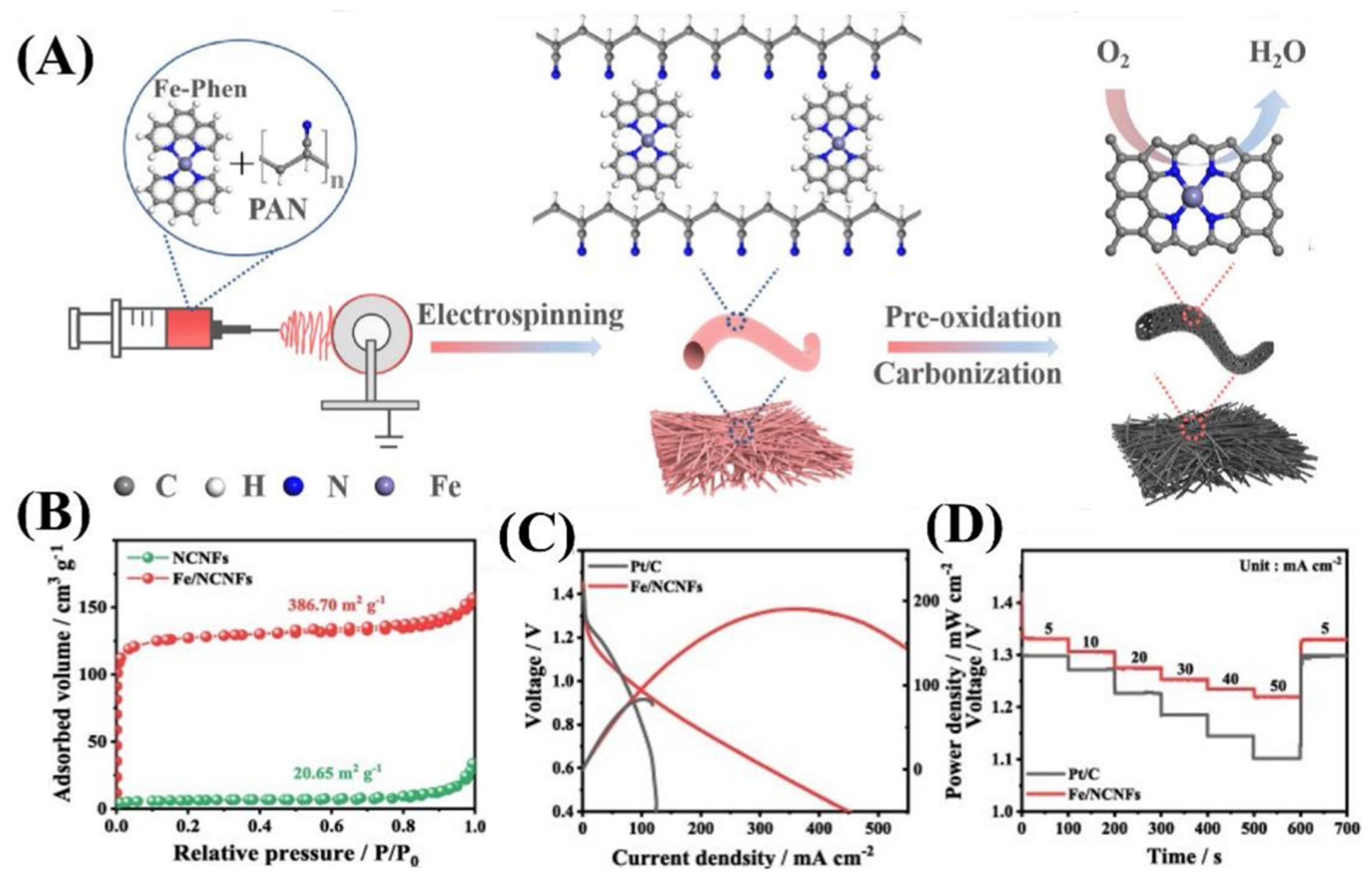
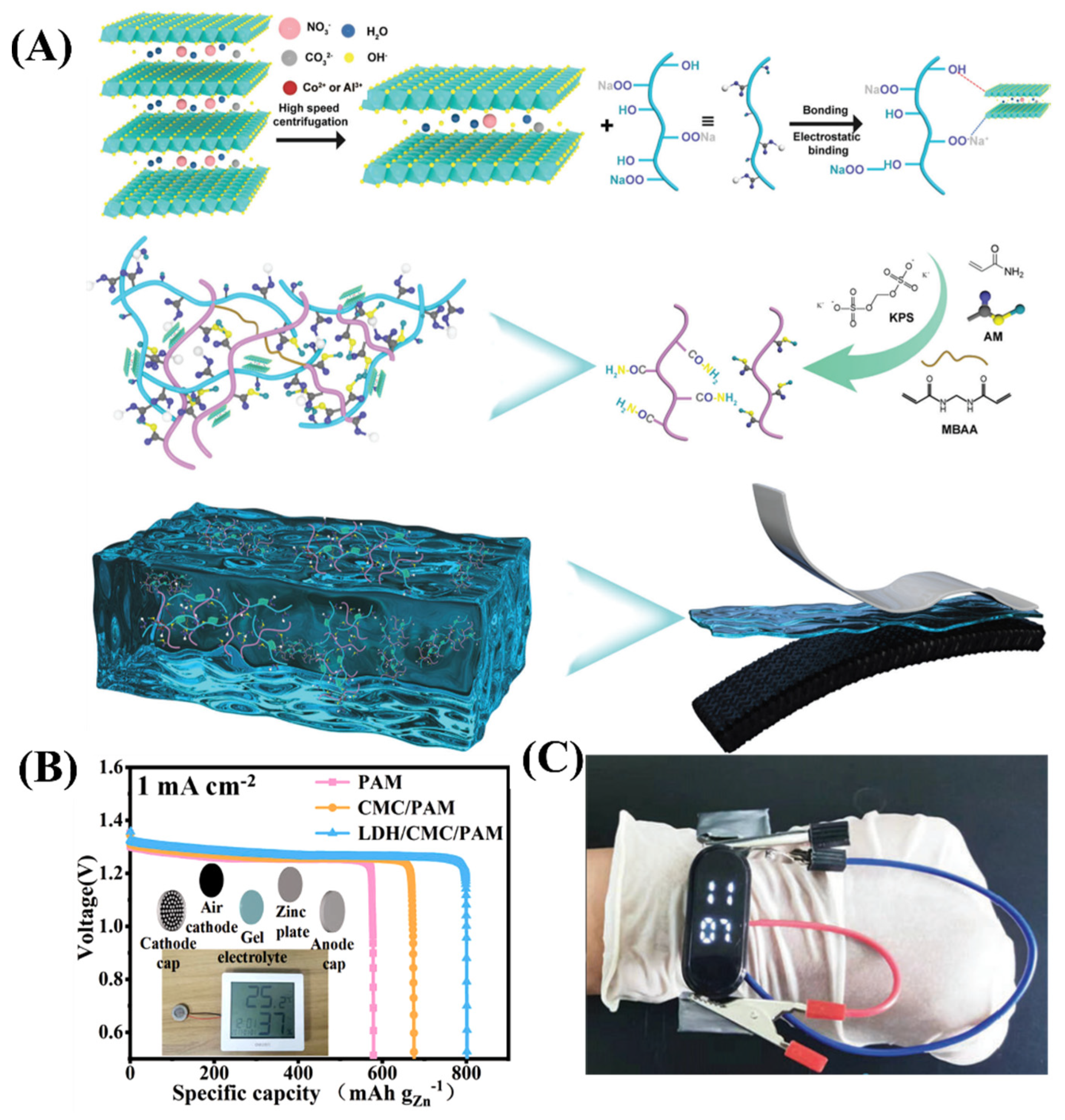
Disclaimer/Publisher’s Note: The statements, opinions and data contained in all publications are solely those of the individual author(s) and contributor(s) and not of MDPI and/or the editor(s). MDPI and/or the editor(s) disclaim responsibility for any injury to people or property resulting from any ideas, methods, instructions or products referred to in the content. |
© 2024 by the author. Licensee MDPI, Basel, Switzerland. This article is an open access article distributed under the terms and conditions of the Creative Commons Attribution (CC BY) license (https://creativecommons.org/licenses/by/4.0/).
Share and Cite
Zhao, H. Recent Advances in Rechargeable Zn-Air Batteries. Molecules 2024, 29, 5313. https://doi.org/10.3390/molecules29225313
Zhao H. Recent Advances in Rechargeable Zn-Air Batteries. Molecules. 2024; 29(22):5313. https://doi.org/10.3390/molecules29225313
Chicago/Turabian StyleZhao, Hui. 2024. "Recent Advances in Rechargeable Zn-Air Batteries" Molecules 29, no. 22: 5313. https://doi.org/10.3390/molecules29225313
APA StyleZhao, H. (2024). Recent Advances in Rechargeable Zn-Air Batteries. Molecules, 29(22), 5313. https://doi.org/10.3390/molecules29225313




